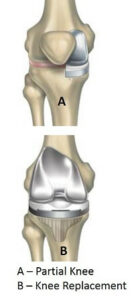Partial Knee Replacement
Partial knee replacement is a minimally invasive surgical procedure that resurfaces the worn, arthritic surfaces of the knee joint with metal and plastic components. Over time, the cartilage covering the ends of the femur (thighbone) and tibia (shinbone) can wear away causing pain, swelling and reduced mobility. If the wear is confined to one area of the knee, partial knee replacement may be an option.
For more information or a physician referral, call us 24/7 at 530-244-5400.
*American Academy of Orthopedic Medicine. Unicompartmental Knee Replacement downloaded at http:// orthoinfo.aaos.org/topic.cfm?topic=A00585 (last reviewed)
What Is the Difference Between Partial and Total Knee Replacement?
 The knee joint is made up of three bones—the femur, the tibia and the patella (or knee cap). The femur contacts the tibia with two areas, called condyles—the medial condyle and the lateral condyle. The underside of the kneecap also contacts the femur and tibia as it glides along the groove in the femur.
The knee joint is made up of three bones—the femur, the tibia and the patella (or knee cap). The femur contacts the tibia with two areas, called condyles—the medial condyle and the lateral condyle. The underside of the kneecap also contacts the femur and tibia as it glides along the groove in the femur.
Any of these three areas of contact can fall victim to the wear and tear effects of arthritis—causing pain, heat, stiffness and swelling.
Total knee replacement involves the replacement of all three surfaces with metal and plastic components. If arthritis is limited to either the lateral or medial compartment of the knee, partial knee replacement may be considered.
Who Is a Candidate for Partial Knee Replacement?
Partial knee replacement may be an option for those who have painful, debilitating arthritis limited to one area of the knee and who no longer get relief from conservative measures, such as physical therapy, medications or weight loss. Only your doctor can determine if you are a candidate for this procedure.
What Are the Advantages?
Because the partial knee replacement artificial joints are smaller than total knee implants, the surgical incision may be smaller.
A smaller incision may lead to a smaller scar. Other potential benefits to partial knee replacement include a quicker operation and a shorter hospital stay (compared with a total knee replacement).* Rehabilitation may also be more accelerated.*
Because less bone is removed and there is less trauma to soft tissue during surgery, your knee may feel more natural than with a total knee replacement.1 Not all patients are candidates for partial knee replacement. Depending on your condition, a total knee replacement may be recommended by your doctor.
How Long Is the Recovery Period?
 Many people will be able to go home the day after the procedure. Because most of the knee joint is left intact after the operation, there is usually less pain than with total knee replacement.
Many people will be able to go home the day after the procedure. Because most of the knee joint is left intact after the operation, there is usually less pain than with total knee replacement.
How Long Will It Last?
All knee replacements can wear out over time, including total knee replacements. How long a particular implant may last varies from patient to patient and depends on a number of factors including the patient’s weight, activity level, and the accuracy of the implant’s placement.
What Are the Risks?
Even though partial knee replacement is considered a minimally invasive procedure, it is still surgery, and as with any surgery, there are risks. Your surgeon and healthcare team will take great care to minimize the risk of complications. Keep in mind that complications are rare, but they need to be understood by you and your family.
Featured Services

Behavioral Health

Emergency Services

Lab Services

Wound Care



